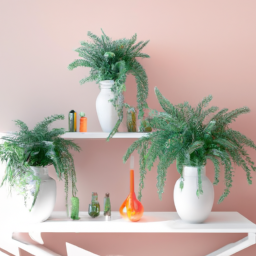
Are you struggling to get a good night’s sleep? Perhaps you’ve tried everything – from adjusting your sleep schedule to investing in a new mattress – but still find yourself tossing and turning. If that’s the case, you may be overlooking a simple yet effective solution: plants. That’s right, plants for better sleep can make a significant difference in creating a serene bedroom environment. In this blog post, we’ll explore the power of plants and how they can transform your bedroom into a peaceful oasis, helping you achieve the restful sleep you deserve. So, let’s dive in and discover the wonderful world of plants for better sleep: creating a serene bedroom.
Importance of Indoor Plants in Creating a Serene Bedroom
Creating a serene bedroom is essential for a good night’s sleep, and one often overlooked element that can greatly contribute to this ambiance is indoor plants. Not only do plants add a touch of natural beauty to your living space, but they also offer numerous benefits for your physical and mental well-being. In this guide, we will explore the importance of indoor plants in creating a serene bedroom and provide you with step-by-step guidance on incorporating them into your sleep sanctuary.
1. Enhancing Air Quality
One of the primary reasons why indoor plants are essential for a serene bedroom is their ability to enhance air quality. Plants act as natural air purifiers, absorbing carbon dioxide and releasing oxygen through the process of photosynthesis. This helps to improve the overall air circulation in your bedroom, ensuring a fresh and clean environment for a good night’s sleep.
Furthermore, certain plants, such as the Snake Plant and Peace Lily, have been found to be particularly effective in removing harmful toxins from the air, such as formaldehyde and benzene. These toxins can be emitted by common household items like paint, furniture, and cleaning products. By having these plants in your bedroom, you can reduce the levels of these pollutants, promoting a healthier indoor environment and facilitating better sleep.
Incorporating air-purifying plants into your bedroom is simple. Choose plants that are known for their air-cleansing properties and place them strategically around the room. Consider placing a Snake Plant on your nightstand or a Peace Lily on a shelf near your bed. Not only will these plants contribute to a serene atmosphere, but they will also help you breathe easier and sleep more soundly.
2. Reducing Stress and Promoting Relaxation
Another significant benefit of indoor plants in creating a serene bedroom is their ability to reduce stress and promote relaxation. Studies have shown that being in the presence of plants can have a calming effect on our minds and bodies. The sight of greenery and the natural patterns of leaves can help to lower blood pressure, reduce anxiety, and induce a sense of tranquility.
Plants also release moisture into the air through a process called transpiration. This can help to increase humidity levels in your bedroom, which is particularly beneficial if you live in a dry climate or during the winter months when indoor heating tends to dry out the air. Adequate humidity can prevent dry skin, irritated sinuses, and even snoring, all of which can disrupt your sleep. Consider incorporating plants like Boston Ferns or Areca Palms that are known for their humidifying properties.
To create a serene atmosphere using plants, choose varieties that have a calming effect on your senses. Lavender, for example, is not only visually appealing but also known for its soothing scent, which can promote relaxation and better sleep. Place a pot of lavender on your bedside table or incorporate it into a hanging basket near your window. The gentle aroma will help you unwind and prepare your mind and body for a restful night’s sleep.
3. Enhancing Aesthetics and Creating a Connection to Nature
Lastly, indoor plants play a crucial role in enhancing the aesthetics of your bedroom and creating a connection to nature. The presence of greenery can transform a dull and lifeless space into a vibrant and inviting sanctuary. Plants add texture, color, and depth to your bedroom, making it visually appealing and calming to the eye.
Consider incorporating a variety of plant types, such as tall floor plants, hanging plants, and smaller potted plants, to create visual interest and balance. Choose plants with different leaf shapes and colors to add diversity and create a harmonious atmosphere. Additionally, you can use decorative planters and stands to further enhance the overall aesthetic appeal of your bedroom.
Furthermore, having plants in your bedroom allows you to establish a connection with nature, even if you live in a bustling urban environment. This connection can have a profound impact on your well-being, reducing stress levels and promoting a sense of peace and tranquility. By surrounding yourself with plants, you bring a piece of the outdoors inside, creating a serene and nurturing environment that supports restful sleep.
In conclusion, indoor plants are not just decorative elements; they are essential for creating a serene bedroom that promotes better sleep. By enhancing air quality, reducing stress, and enhancing aesthetics, plants contribute to a peaceful and restorative atmosphere. So, why not bring the beauty of nature into your bedroom and enjoy the multitude of benefits that indoor plants have to offer?

Best Plant Choices for Better Sleep in Your Bedroom
Sleep is an essential part of our daily routine, and creating a serene bedroom environment can greatly improve the quality of our rest. One effective way to enhance the tranquility of your bedroom is by incorporating plants that promote better sleep. Not only do plants add a touch of nature to your space, but they also purify the air and release soothing scents that can help you relax and unwind. In this guide, we will explore the best plant choices for better sleep in your bedroom, ensuring you wake up feeling refreshed and rejuvenated every morning.
1. Lavender
Lavender, with its calming and aromatic properties, is a popular choice for promoting sleep. Its gentle scent has been shown to reduce anxiety and promote relaxation, making it an ideal addition to your bedroom. Place a potted lavender plant on your nightstand or near your bed to enjoy its soothing fragrance throughout the night. You can also consider using lavender essential oil in a diffuser for a more concentrated effect.
In addition to its calming scent, lavender also has a visually pleasing appearance with its delicate purple flowers. This plant thrives in bright, indirect sunlight and requires minimal care, making it an excellent choice for those new to plant care or with limited time for maintenance.
Remember to water your lavender plant regularly, but avoid overwatering as it prefers slightly dry soil. With its calming scent and beautiful blooms, lavender is a top choice for creating a serene bedroom environment conducive to better sleep.
2. Snake Plant
The snake plant, also known as Sansevieria or mother-in-law’s tongue, is a popular choice for bedrooms due to its ability to purify the air. This plant releases oxygen at night, making it an excellent addition to your sleeping space. Snake plants are known to filter out toxins such as formaldehyde, benzene, and trichloroethylene, helping to create a cleaner and healthier environment for sleep.
Snake plants are also low-maintenance and can tolerate a wide range of light conditions, from bright indirect light to low light. This makes them suitable for bedrooms with varying levels of natural light. Additionally, snake plants have a unique and striking appearance with their tall, upright leaves that resemble swords. They can add a touch of elegance and tranquility to your bedroom decor.
When caring for a snake plant, allow the soil to dry out between waterings, as overwatering can cause root rot. With its air-purifying qualities and visually appealing foliage, the snake plant is an excellent choice for creating a serene sleeping environment.
3. Aloe Vera
Aloe vera, known for its medicinal properties, is another plant that can enhance the quality of your sleep. This succulent plant releases oxygen at night, similar to the snake plant, helping to improve the air quality in your bedroom. Aloe vera also has the added benefit of its gel, which can be used to soothe skin irritations and promote relaxation.
Place an aloe vera plant on your bedside table or near a window to benefit from its air-purifying properties and to have easy access to its gel. Aloe vera plants thrive in bright, indirect sunlight and require minimal watering. They are also known to be resilient and can withstand neglect, making them a great choice for those with busy schedules.
When caring for an aloe vera plant, ensure that the soil is well-drained and allow it to dry out between waterings. Overwatering can lead to root rot and damage the plant. With its air-purifying qualities and versatile gel, aloe vera is a wonderful addition to any bedroom seeking a serene atmosphere.
By incorporating these plant choices into your bedroom, you can create a serene environment that promotes better sleep. The calming scents, air-purifying qualities, and visually pleasing appearances of lavender, snake plants, and aloe vera can transform your bedroom into a tranquil oasis. Remember to consider your bedroom’s lighting conditions and your availability for plant care when selecting the best plants for your sleeping space. With these plants by your side, you’ll be on your way to enjoying a restful night’s sleep and waking up feeling refreshed and rejuvenated each morning.

Plants for Better Sleep: Creating a Serene Bedroom
Tips for Incorporating Plants into Your Bedroom Décor for a Peaceful Sleep Environment
Having trouble falling asleep or staying asleep at night? Creating a serene bedroom environment can greatly improve the quality of your sleep. One effective way to achieve this is by incorporating plants into your bedroom décor. Not only do plants add a touch of natural beauty to your space, but they also have numerous benefits for your sleep and overall well-being. In this article, we will discuss some tips on how to choose and arrange plants in your bedroom to create a peaceful sleep environment.
1. Choose the Right Plants
When selecting plants for your bedroom, it is important to choose those that promote relaxation and have air-purifying qualities. Some of the best plants for better sleep include:
Lavender: Known for its calming aroma, lavender can help reduce anxiety and promote a more restful sleep. Consider placing a potted lavender plant on your nightstand or near your bed.
Aloe Vera: Aloe vera emits oxygen at night, making it an excellent choice for your bedroom. This plant also has air-purifying properties, helping to create a cleaner and fresher sleep environment.
Jasmine: Jasmine has a gentle and soothing scent that can help reduce anxiety and improve sleep quality. Place a jasmine plant on a shelf or windowsill in your bedroom.
2. Consider Lighting and Placement
When it comes to incorporating plants into your bedroom décor, consider the lighting and placement of each plant. Some plants thrive in bright, indirect sunlight, while others prefer low light conditions. Take into account the natural light in your bedroom and choose plants accordingly.
Additionally, consider the size and shape of your plants. Taller plants like snake plants or peace lilies can be placed in corners or near windows, while smaller plants like succulents or herbs can be placed on shelves or nightstands.
Remember to leave enough space for your plants to grow and spread their leaves. Overcrowding can hinder their growth and affect their overall health.
3. Create a Calming Display
Arranging your plants in an aesthetically pleasing manner can enhance the overall tranquility of your bedroom. Consider creating a calming display by grouping plants with similar care requirements together.
You can also add decorative elements such as pebbles, fairy lights, or small figurines to enhance the visual appeal of your plant arrangement. Be creative and experiment with different combinations to find what works best for your bedroom.
Remember to regularly dust and clean your plants to keep them looking fresh and vibrant. Remove any dead leaves or flowers to maintain their overall health.
In conclusion, incorporating plants into your bedroom décor can greatly improve your sleep environment. Choose plants that promote relaxation and have air-purifying qualities, consider lighting and placement, and create a calming display. By following these tips, you can create a serene bedroom that promotes better sleep and overall well-being. Sweet dreams!
In Summary
Having trouble falling asleep at night? You’re not alone. Many people struggle with getting a good night’s sleep, which can have a negative impact on their overall well-being. But what if I told you that you could improve your sleep simply by adding a few plants to your bedroom? It may sound too good to be true, but studies have shown that certain plants have the ability to create a serene and calming environment that promotes better sleep.
One of the best plants for better sleep is the lavender plant. Known for its soothing scent, lavender has been used for centuries to promote relaxation and reduce anxiety. Placing a lavender plant in your bedroom can help create a peaceful atmosphere that is conducive to sleep. Another great plant to consider is the snake plant, also known as mother-in-law’s tongue. This plant is not only easy to care for but also has the ability to improve air quality by removing toxins from the air. By purifying the air in your bedroom, the snake plant can help you breathe easier and sleep better.
Here are this week’s Top Questions and Answers
Q1: What are some plants that can help create a serene bedroom and improve sleep?
A1: There are several plants known for their calming properties that can promote better sleep. Some popular choices include lavender, jasmine, snake plant, aloe vera, and peace lily. These plants not only add a touch of greenery to your bedroom but also release soothing scents and purify the air, creating a more serene environment for a good night’s sleep.
Q2: How do plants like lavender and jasmine help improve sleep?
A2: Lavender and jasmine are renowned for their relaxing and sleep-inducing properties. Lavender has a calming scent that can reduce anxiety and stress, while jasmine has been shown to improve sleep quality and increase alertness during the day. These plants can help create a peaceful atmosphere in your bedroom, making it easier to unwind and drift off to sleep.
Q3: Can plants really purify the air in the bedroom?
A3: Yes, certain plants have the ability to purify the air by removing toxins and releasing oxygen. Snake plants, aloe vera, and peace lilies are excellent choices for improving indoor air quality. These plants absorb harmful chemicals commonly found in cleaning products, paints, and furniture, helping to create a healthier sleep environment.
Q4: Do I need a green thumb to take care of these plants?
A4: Not at all! Many of the plants known for their sleep-enhancing properties are low-maintenance and require minimal attention. Snake plants and aloe vera, for example, are hardy plants that can tolerate a variety of conditions and only need occasional watering. Peace lilies and jasmine may require a bit more care, but they are still relatively easy to manage. Just make sure to place them in proper lighting conditions and water them as needed.
Q5: Can I place these plants in my bedroom if I have allergies?
A5: If you have allergies, it’s important to choose plants that are less likely to trigger your symptoms. While lavender and jasmine are generally well-tolerated, some individuals may be sensitive to their scents. Snake plants, aloe vera, and peace lilies are typically considered safe options for those with allergies, as they have minimal pollen production. However, it’s always a good idea to monitor your reactions and consult with a healthcare professional if you have any concerns.
Dr. Olivia Green is a botanist with over two decades of experience in indoor plant cultivation. She holds a Ph.D. in Plant Biology and has dedicated her career to researching plant behavior in controlled environments. Dr. Green is passionate about helping plant enthusiasts master the art of indoor gardening through her extensive knowledge and practical insights.


